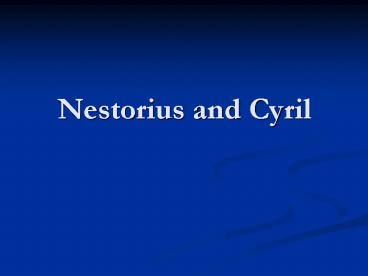Nestorius and Cyril - PowerPoint PPT Presentation
1 / 8
Title:
Nestorius and Cyril
Description:
Nestorius and Cyril Background Nicea Arius condemned Son is of the same substance (homo-ousios) as the Father Does not end the debate Arian bishops, emperors continue ... – PowerPoint PPT presentation
Number of Views:90
Avg rating:3.0/5.0
Title: Nestorius and Cyril
1
Nestorius and Cyril
2
Background
- Nicea
- Arius condemned
- Son is of the same substance (homo-ousios) as the
Father - Does not end the debate
- Arian bishops, emperors continue
- Objections to Nicea
- homoousios not biblical
- Sounds Sabellian better to say Son is of like
substance (homoi-ousios) - Is divine Logos the soul of Christ?
3
Nestorius (ca. 381-451)
- Agrees with Nicea
- Chidester, 143 all agreed on divinity of Christ,
but differed in views of Christs humanity - Bishop of Constantinople, 428-431
- eastern capital of the Roman empire and one of
the five major churches - Provokes a major controversy by objecting to a
popular liturgical practice why?
4
Terms
- Nature (Greek Physis) what all beings of a
species share. Can only exist as instantiated in
a person. - Example Human nature, dog nature, divine nature
- Person (Greek Hypostasis) individual
instantiation of a nature. - A person must also have a nature nature only
exists as instantiated in persons. - Example Paul and Mattea Rover and Fluffy
5
Theotokos controversy
- Liturgy people called Mary the God-bearer
(Grk. Theotokos) - Lex orandi, lex credendi The law of prayer
shapes the law of belief - Nestorius objects to theotokos why?
- God was not born at a point in time
- Need to distinguish human and divine natures of
Christ - Like Athanasius, just as Logos suffered in the
flesh, so Christ, not God, was born of Mary - Must be careful with language to avoid heresies
(God suffers)
6
Cyril of Alexandria (ca. 375-444)
- Bishop of Alexandria
- Ambitious
- Wanted to assert Alexandrias authority over
Constantinople - Cyril defends theotokos. Issue who is the
subject/person in Jesus, the Word Incarnate? - CC 27 While remaining God, , the Logos took on,
became subject of, human life - Once human and divine have been united, cannot be
separated, because there is one subject - Hypostatic union two natures united in one
person - Union is essential to salvationwhy?
- Cyril misrepresents Nestorius
7
Results
- Ephesus, 431
- Affirms Theotokos
- Nestorius resigns as bishop
- 431-451 debate continues, Pope Leo I steps in
- 451 Council of Chalcedon settles problem
- Provides conceptual and terminological precision
- Yet, plenty of room for thought and debate remain
- But, Nestorian churches still exist
8
For next time
- Pope Leo I
- What ideas (of Eutyches) does Leo reject, and
why? - How does he define person and natures?
- Council of Chalcedon (451)
- In what ways does the council strike a middle
ground between Cyril and Nestorius? - How does the council try to balance discussion of
human and divine natures?































